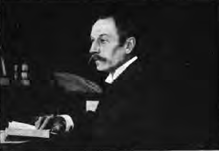Paul Joire
Paul Joire (1856–1930) was a leading French parapsychologist, professor at the "Psycho-physiological Institute of France" and president of the "Societé Universelle d'Études Psychiques" ("Universal Society of Psychic Studies").[1]
Paul Joire | |
|---|---|
 | |
| Born | 1856 |
| Died | 1930 |
| Occupation | Parapsychologist, writer |
Work
Paul Joire researched and wrote extensively about hypnotism and its experimental and therapeutic uses in "Traité de l'hypnotisme expérimental et thérapeutique" (1908).[2] He investigated many parapsychological phenomena, such as the "exteriorisation of sensibility", associated with hypnotism, in which the hypnotised subject appears to be able to receive sensations at a distance, as if his nervous sensitivity extended beyond the boundary of the physical body;[3] and "motricity", the movement of objects, without contact, apparently by some force emanating from the human body, often associated with mediumship and seances.[4]
He devised an instrument called a sthenometer (a type of "biometer"[5]) which, he claimed, could detect the "nervous force" emitted by the body, and about which he wrote several papers.[6] The device consisted of a circular dial, marked off in degrees, in the centre of which was a delicate needle, balanced on a pivot and the whole covered by a glass case (see illustration). It was found that when the extended fingers of a subject's hand were placed near the side of the device, a deflection of the needle was observed, attributable, according to Joire, to the "nervous force" emanating from the body. He thought that this force was modified and disturbed by states of illness in the subject and therefore the sthenometer could be useful in diagnosis and treatment.[7] The nervous force was disputed by other researchers. In 1907, F. J. M. Stratton tested the device and concluded the results were due to the influence of the hands body heat.[8][9]
Joire also investigated and documented, ESP (extra-sensory perception), levitation, automatic writing, "spirit rapping" (typtology), spirit photography, mediumship and materialisation phenomena etc.[10]
Publications

- Traité D'Hypnotisme Expérimental Et De Psychothérapie (1914)
- Psychical and Supernormal Phenomena: Their Observation and Experimentation (New York: Frederick A. Stokes, 1916).
See also
- Hippolyte Baraduc
- Émile Boirac
- Joseph Grasset
- Albert de Rochas
References
- Lewis Spence. Encyclopedia of Encyclopedia of Occultism and Parapsychology (Dodd, Mead & Co, 1920) p 484.
- Joire, Paul. Traité de l'hypnotisme expérimental et thérapeutique (Paris: Vigot freres, 1908).
- Spence, 1920, p. 317.
- Joire, Psychical and supernormal phenomena, 1916, pp. 414-425
- A term coined to describe various types of devices claimed to be able to respond to the human aura. See Joseph Grasset, The marvels beyond science (New York; Funk & Wagnalls company, 1910).
- Joire, Paul. Modifications in the nervous force externalised, according to the state of health of the subjects. The Annals of Psychical Science, no. 4, Oct 1905 (Kessinger Publishing, 2004 - Laura I. Finch [Ed.], p. 219).
- Joire, Psychical and supernormal phenomena, 1916, pp. 416-418.
- Stratton F. J. M; Phillips, P. (1906). Some Experiments with the Sthenometer. Journal of the Society for Psychical Research 12: 335-339.
- "Some Experiments with the Sthenometer: Evaluating Dr Joire’s Results". Retrieved 12 June 2017.
- Joire, Psychical and supernormal phenomena, 1916.
External links
- Books and published papers of Paul Joire (Bibliothèque Nationale de France)